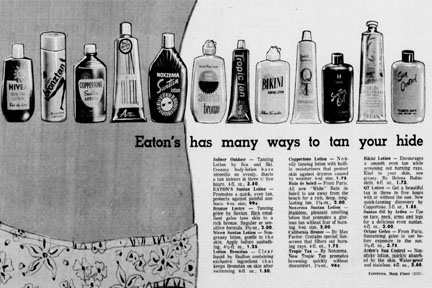
Start your tan with many products from Eaton’s – 1966 ad.
You are brown as a berry, one might once have said to someone who had achieved an enviable deep and glowing tan. That sun-kissed look was all the rage at one time. A real tan, without blotching, burning, or peeling. A tan that lasts.
Tanning was not always so desirable. Dickies From Gunton: Canadian Brothers in Two World Wars remembered their mother outside in the summer. With her sunhat and long skirts, only her forearms would get any sun when she rolled up her sleeves to get to work. And the ladies would often rest in the shade.
The boys themselves grew up spending a lot of time outdoors, but they too wore caps on their heads and rolled up their long sleeves or simply wore undershirts (t-shirts) to get to work on the farm on a hot summer’s day. So the sun darkened only part of their arms in what would come to be known as a farmer’s tan.
In his youth, Percy sketched beautiful women with dark hair and pale skin. The girls he knew were fair. They were only out in the sun at the beach, in the sand and to swim on a weekend or holiday. That’s when he and his brother also wore their swimsuits (with a top and bottom), and soaked up some sun with the children. But on the beach and in the water, they loved the warmth of the sun on their skin and if they returned home with a bit of colour, it was a sign they had enjoyed a good time.
At the start of the Second World War, Earl enjoyed his time under the tropical sun in Jamaica with the Winnipeg Grenadiers. He returned with a sun-kissed glow about him, a reflection of good health and relaxation. A child who was too pale and sickly looking was encouraged to get out and get some sun. Being brown as a berry was a good thing. The Dickie children spent long hours in the sun and grew up to enjoy a good suntan.
Suntan oils and lotions are soon available to prevent burning and help attain a beautiful tan. Season the skin by building up your exposure time to avoid burning, women are advised.
By 1977, a numbered code system rates sunscreens and sunblocks from 2 to 10. If you burn in the sun in two hours unprotected, you can stay out for four hours with a 2 or tan more slowly with a higher number, women are advised.
By the 1990s, SPF from 15 to 30 is common.
Today, Health Canada says, “Sunscreens are not meant to increase the amount of time you can spend in the sun without burning. They are meant to provide protection while you are exposed to the sun’s UV rays.” They now recommend an SPF of 30 or higher. SPF 30 blocks 93 per cent of UVB rays. Broad spectrum sunscreen, clothing, hats, and shade can protect from the sun.
The Canadian Cancer Society now says you don’t have to spend “more than a few minutes out in the sun to get your Vitamin D. There is no need to intentionally expose yourself to the sun or visit tanning beds.”
In the early days of the 20th century, the boys’ mom may not have had the scientific warnings, but maybe she may have been right to stay out of the sun.
